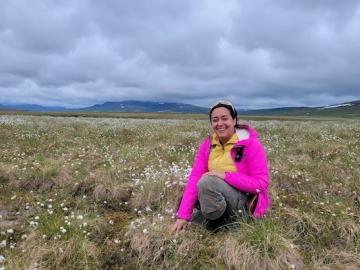Filter News
Area of Research
- (-) Biology and Environment (52)
- Advanced Manufacturing (2)
- Biology and Soft Matter (1)
- Building Technologies (2)
- Clean Energy (49)
- Computational Biology (1)
- Computer Science (1)
- Electricity and Smart Grid (1)
- Functional Materials for Energy (2)
- Fusion and Fission (15)
- Isotopes (3)
- Materials (43)
- Materials for Computing (6)
- National Security (25)
- Neutron Science (14)
- Renewable Energy (1)
- Supercomputing (39)
News Topics
- 3-D Printing/Advanced Manufacturing (3)
- Advanced Reactors (1)
- Artificial Intelligence (3)
- Big Data (1)
- Bioenergy (15)
- Biology (26)
- Biomedical (2)
- Biotechnology (3)
- Buildings (1)
- Chemical Sciences (6)
- Clean Water (2)
- Climate Change (16)
- Composites (2)
- Computer Science (3)
- Coronavirus (2)
- Critical Materials (1)
- Cybersecurity (1)
- Decarbonization (8)
- Energy Storage (4)
- Environment (24)
- Exascale Computing (1)
- Frontier (1)
- Grid (2)
- High-Performance Computing (4)
- Hydropower (5)
- Machine Learning (3)
- Materials (4)
- Materials Science (2)
- Mercury (1)
- Microscopy (6)
- Nanotechnology (2)
- National Security (1)
- Net Zero (1)
- Neutron Science (1)
- Nuclear Energy (1)
- Partnerships (3)
- Polymers (1)
- Security (1)
- Simulation (1)
- Summit (2)
- Sustainable Energy (9)
- Transformational Challenge Reactor (1)
- Transportation (1)
Media Contacts

Scientists working on a solution for plastic waste have developed a two-step chemical and biological process to break down and upcycle mixed plastics into valuable bioproducts.

Millions of miles of pipelines and conduits across the United States make up an intricate network of waterways used for municipal, agricultural and industrial purposes.

Tomás Rush began studying the mysteries of fungi in fifth grade and spent his college intern days tromping through forests, swamps and agricultural lands searching for signs of fungal plant pathogens causing disease on host plants.
A team from Oak Ridge National Laboratory, Duke University and other institutions studying Sphagnum moss have identified two new species in North America, and they are learning how evolution may affect the species’ role in carbon storage.

ORNL researchers are deploying their broad expertise in climate data and modeling to create science-based mitigation strategies for cities stressed by climate change as part of two U.S. Department of Energy Urban Integrated Field Laboratory projects.

ORNL has provided hydropower operators with new data to better prepare for extreme weather events and shifts in seasonal energy demands caused by climate change.

A new paper published in Nature Communications adds further evidence to the bradykinin storm theory of COVID-19’s viral pathogenesis — a theory that was posited two years ago by a team of researchers at the Department of Energy’s Oak Ridge National Laboratory.

When Hurricane Maria battered Puerto Rico in 2017, winds snapped trees and destroyed homes, while heavy rains transformed streets into rivers. But after the storm passed, the human toll continued to grow as residents struggled without electricity for months. Five years later, power outages remain long and frequent.

With wildfires increasing in scope and intensity around the world, Fernanda Santos’ research into how such calamities affect soil carbon storage has taken on new urgency.

Global carbon emissions from inland waters such as lakes, rivers, streams and ponds are being undercounted by about 13% and will likely continue to rise given climate events and land use changes, ORNL scientists found.




